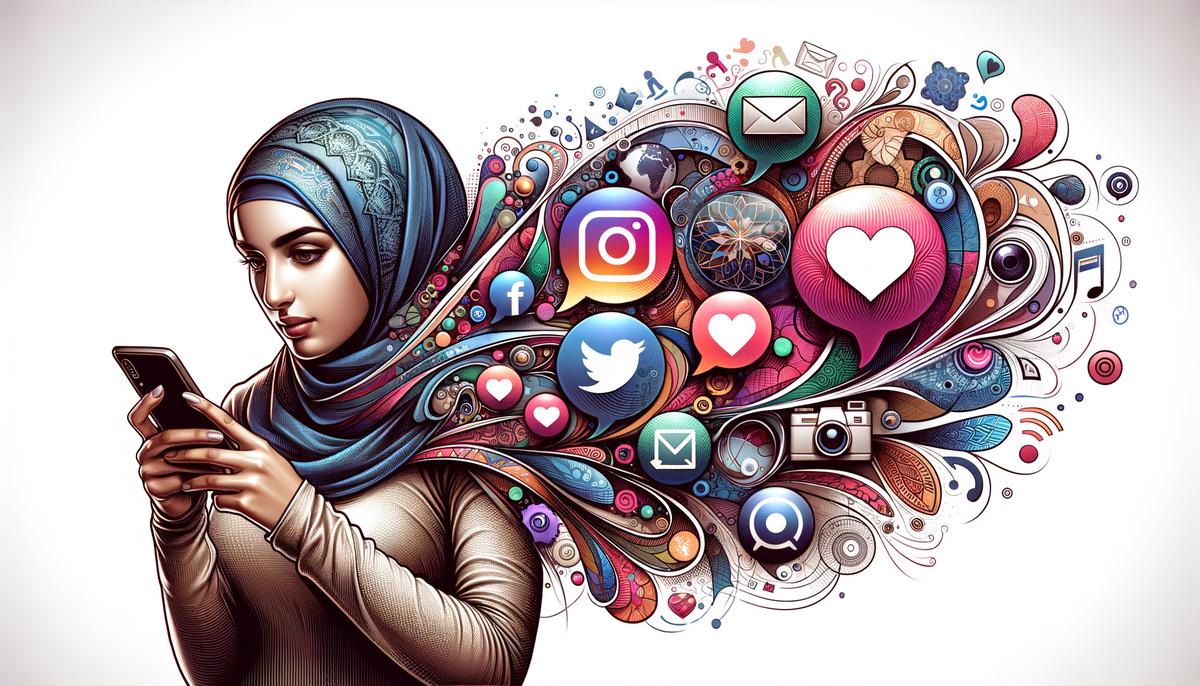AI Integration in Content Creation
2024 sees artificial intelligence reshaping content marketing strategies, with a direct impact on creating more personalized and efficient content. AI technologies like Midjourney and ContentShake AI are at the forefront of this revolution, enabling marketers to generate dynamic content rapidly. However, striking a balance between AI-generated content and the irreplaceable human touch remains a critical consideration.
Tools such as Midjourney serve marketers by producing high-quality images customized to specific campaign needs, harnessing AI's capability to understand and interpret visual content requirements. This functionality isn't just about speed but also about maintaining brand consistency across multiple platforms without the need for extensive human intervention in the initial stages.
On the flip side, ContentShake AI facilitates the generation of structured content outlines based on predefined inputs, fostering a seamless blend of human expertise and AI efficiency. This allows content creators to establish a detailed framework which they can then expand with human insight and creativity. The result? Content that resonates more personally with the audience, blending the best of AI efficiency and human authenticity.
The integration of AI can elevate personalization in content marketing to extraordinary levels. Imagine delivering content that adapts in real-time to user interactions; this kind of hyper-personalization drives engagement but leans heavily on AI's ability to analyze data quickly and accurately.
Despite these advancements, the distinction between AI-assisted and purely AI-generated content is vital. Pure AI content can sometimes lack the nuanced understanding of human emotion and cultural contexts, which are crucial for truly connective marketing. Thus, while AI tools streamline productivity and handle the heavy lifting of data management and initial content drafting, creative direction should distinctly remain a human-led domain.

Evolving Social Media Dynamics
Navigating the transition from traditional search engines to burgeoning social media platforms like TikTok and Instagram as primary sources for content discovery epitomizes the dynamic nature of today's content marketing. This shift is consequential, influencing both the strategies marketers employ and the analytics they value. With a trajectory particularly pronounced among Generation Z, content discovery through social media is propelled not just by the novelty of platforms but also by their alignment with user preferences for quick, digestible, and visually engaging content.
For marketers, this evolution demands a reframing of content optimization strategies. Historically reliant on SEO tactics customized for search engines like Google, professionals must now embrace the nuances that define virality on social media networks. On platforms such as TikTok, content that hooks the viewer in the first few seconds using captivating visuals or engaging starts has a higher likelihood of trending. The informal and direct communication style favored on these platforms often yields better engagement compared to the more formal tones that might be prevalent in search-engine-optimized content.
Using social media-native features such as hashtags, trending challenges, and collaboration tools can amplify outreach. This not just horizontally expands the reach but also deepens user engagement through interactive and community-driven content styles which resonate well on these platforms. Instagram Reels and TikTok videos, for example, present unique opportunities for marketers to participate in real-time conversations and trends, turning every post into a potential touchpoint that encourages user interaction.
As content consumption moves more towards these platforms, the data derived from user interactions becomes greatly vital. Marketers can harness this data to gain insights into user behavior and preferences which, in turn, can guide the creation of more personalized content. The very nature of these platforms—with their algorithmically curated feeds that prioritize content visibility based on user interaction—dictates a move towards content that not only captures attention but also maintains engagement over time.
Therefore, as we tread deeper into 2024, it's clear that integrating platform-specific best practices into content strategy is not merely an option but a necessity. This paradigmic shift not only challenges marketers to adopt and adapt but also to constantly innovate, crafting content that is not only seen but also resonates and inspires interaction. As these dynamic platforms evolve, so too must the strategies that drive meaningful engagement in this new era of digital marketing.

The Rise of Video and Podcast Content
As 2024 unfolds, video and podcast content continue to dominate consumer preferences, necessitating their strategic integration into comprehensive marketing campaigns. This evolution in content consumption underscores not just a change in medium but also a shift in audience engagement patterns and expectations.
The growing preference for video content is evident, with platforms such as YouTube, TikTok, and Instagram Reels leading the charge. These mediums offer distinct advantages in terms of visual appeal and immediacy, providing marketers with fertile ground to deploy captivating stories and vibrant visuals that stand out in the crowded digital landscape. High-quality video production no longer just catches the eye; it's essential for retaining viewer engagement in a rapidly scrolling world.
Similarly, podcasts offer marketers a unique content vehicle renowned for its ability to maintain audience engagement through immersive storytelling. The intimacy of voice conveys authenticity and fosters a stronger connection between host and listener, a phenomenon significantly beneficial for brands looking to establish trust with their audience. As podcast listeners often multitask while tuning in, this format provides an unparalleled opportunity to reach audiences during moments other media formats may not, such as commuting or while performing household chores.
The integration of SEO strategies within video and podcast content is increasingly critical. For video content, practices like optimizing video titles, descriptions, and tags with targeted keywords can drastically affect discoverability. Adding subtitles and closed captions not only makes videos more accessible but also meshes seamlessly with Google's speech recognition algorithms, enhancing SEO standings. For podcasts, consider the following:
- Embedding keywords strategically in show notes
- Providing comprehensive episode descriptions
- Transcribing episodes to powerfully boost their visibility across search engines and dedicated podcast platforms
The relevance of analytics cannot be overstated. Modern digital tools and platforms offer insights into viewer and listener behaviors—what works, what doesn't, and why? This intelligence is indispensable as it steers future content initiatives, ensuring they align more closely with user interests and emerging trends, keeping marketing strategies resilient in the face of evolving digital content consumption patterns.
As we look towards leveraging video and podcast content in 2024's content marketing stratagems, the focus should not only rest on crafting visually appealing or aurally engaging content but also on upholding high-quality standards, optimizing for search engines, and strategically fostering long-term audience engagement. These efforts will collectively serve to elevate brand presence, imbue authenticity in communication, and ultimately, drive the conversion needle amidst an era of enhanced digital storytelling.

Employee Brand Ambassadors
Empowering employees to become brand ambassadors represents a pivotal shift in content marketing dynamics, particularly as attention to genuineness and transparency grows among diverse audiences. When employees share personal stories, expert insights, or behind-the-scenes glimpses from their viewpoints, it brings life and authenticity to a brand. For businesses attuned to craft earnest connections with their demographic, developing employee-driven content eclipses traditional corporate communication barriers and fosters invaluable trust.
Leveraging the personal brands of employees caters to an ever-personalized encounter with potential customers. As each employee brings a unique voice and network, they can interact meaningfully in spaces where corporate entities might seem obtrusive. For example, an enthusiastic software engineer blogging about day-to-day challenges and wins, or a creative director sharing thought leadership articles through their LinkedIn can make the brand relatable and approachable. These pieces of content resonate particularly well because they come from individuals' hands-on experiences and personal involvement with the company's workflow and achievements.
To cultivate such environments efficiently, brands need well-defined strategies that encourage employees while safeguarding brand image and confidentiality. Encouragements can be formal, like structured employee advocacy programs that offer rewards for social shares, or informal support and recognition in daily workframes. It's wise to provide employees with clear guidelines regarding company values and permitted disclosures, reducing potential conflicts or misunderstandings about brand representation.
Integrated within these strategies, practical training sessions geared towards enhancing employees' understanding of effective social media use are instrumental. Teaching the ropes on engaging storytelling and the use of visual content can elevate the natural interaction employees have on these platforms. Incorporating workshops or seminars by social media experts can profoundly impact confidence, skillsets, and ultimately, the performance of content shared.
Businesses should facilitate acceptance seamlessly into employees' routines. Technology and tools that easily accommodate sharing brand content or co-editing among teams can enhance participation rates. Similarly, open-ended feedback mechanisms where employee contributions can be reviewed and refined by marketing teams ensure the message stays coherent and aligned with the overarching brand narrative.
The symbiotic relationship developed through employee-driven strategies paves the way for more organic reach and engagement. The profound resonance situated in realness becomes evident as employee-shared narratives yield increased interactions, establishing a brand's reputation firmly rooted in authenticity and enriched by trust. As we extend into 2024 and beyond, brands that harness the collective capabilities and personalities of their employees will likely lead dialogues in their industries and foster loyalty that withstands the fervor of ever-evolving market dynamics.
User-Generated Content (UGC) Strategy
In the landscape of 2024's content marketing strategies, user-generated content (UGC) holds a special place, continuing to drive both community trust and engagement in an era dominated by the quest for authenticity. UGC, ranging from simple product reviews and social media posts to customer-created videos and blogs, offers an indisputable air of authenticity—a critical quality as customers increasingly distrust scripted advertising and generic brand messages.
The potent efficacy of UGC lies in its grassroots nature—content created by regular users resonates deeply as it emerges as untainted by corporate interests. It's compelling, capable of swaying purchasing decisions simply because it stems from relatable, real-life experiences of peers. This underlines a form of social proof that bolsters consumer confidence far more than high-budget marketing campaigns can manage alone.
To harness the power of UGC effectively, brands must foster an engaged community where creating and sharing content is encouraged and rewarded. Implementing a strategy to promote UGC involves motivating your audience to contribute actively, making them feel like an integral part of the brand's journey. Here are several tried-and-tested methods to enhance UGC contributions:
- Incentivization: Offering tangible rewards such as discounts, contests, giveaways, or even showcasing contributors on mainstream platforms can stimulate community members to share their unique content. It's crucial that these initiatives are aligned with your brand's values and resonate well with your target demographic.
- Hashtag Campaigns: Creating unique hashtags for new product launches or community challenges can spur users to post content related to your brand, making it easy to find and feature their submissions across your marketing channels.
- Simplified Sharing Mechanisms: Ease of content submission is key. Ensure that your digital platforms support easy uploading capabilities and are intuitive for the users. Clear instructions on how to share content and what type of content is needed can also boost participation rates.
- Engagement with Contributors: Brands should encourage UGC and actively engage with contributors by commenting on, liking, and sharing their content. This engagement reinforces community feeling and encourages continual participation from the community.
- Featuring UGC Regularly: Consistently incorporating user-generated content in your marketing—on social media feeds, in newsletters, or even in advertising—demonstrates a genuine appreciation for it. This not only feeds the content cycle with fresh material but also builds a collaborative brand image.
The strategic usage of UGC can radically impact consumer behavior. It humanizes a brand, breaks down corporate barriers, and establishes a trusting relationship that encourages ongoing loyalty. Communities thriving on robust UGC contributions are likely to witness higher engagement rates, improved conversion paths, and increased time spent on digital platforms due to the inherently social and interactive form of the content.
Moving forward into 2024, incorporating UGC should be a fundamental component of marketing strategies. Successful integration of user-generated content could mean the difference between a brand that merely engages and one that inspires. Brands that position their users as co-creators emerge as market leaders, displaying a confident stance grounded in community-oriented values and transparent interaction.

Leave a Reply